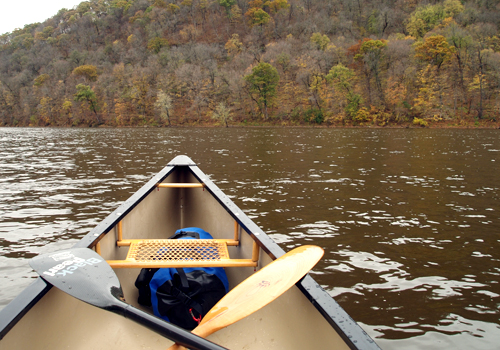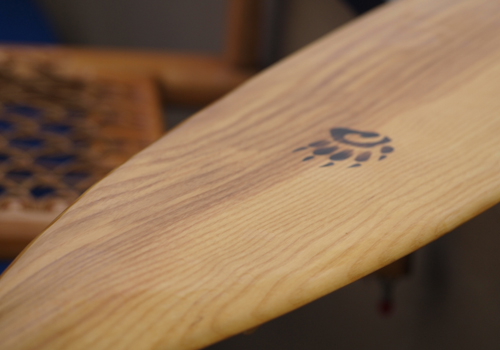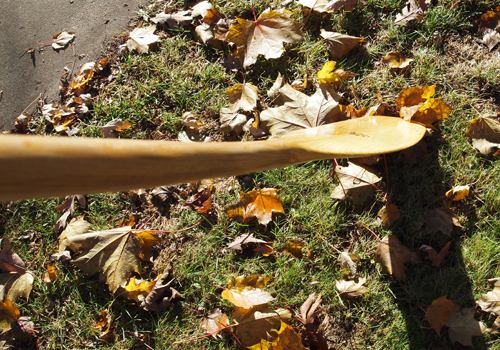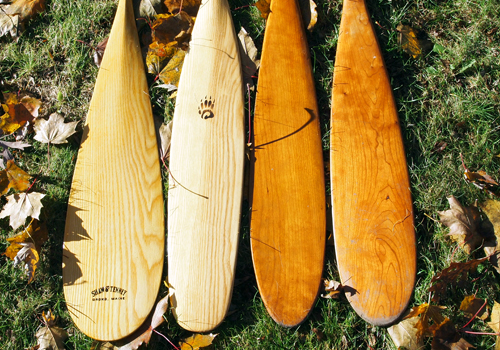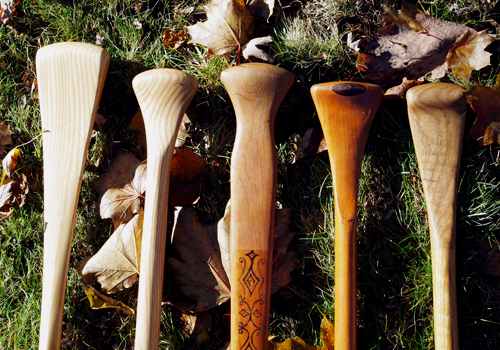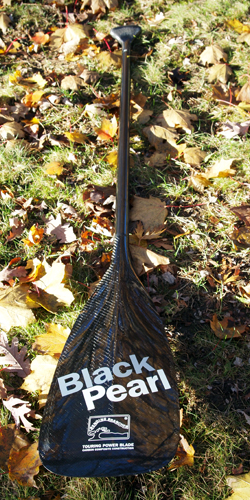Our recent staff retreat gave me the opportunity to demo a few paddles that are (now) in the product mix for 2012. It was a perfect opportunity for side-by-side comparisons. Interestingly, these two paddles couldn’t be more different, but I really liked them both. Here’s a synopsis.
Badgertail
Badger Paddles is a newcomer to the US. A Canadian company, until now they only sold in the US via their website. Since Jodie closed up shop at Turtle Paddles years ago, I’ve been searching for a manufacturer to take his place. Yankee companies haven’t quite nailed the solid wood traditional paddle. There are approximations that are okay, but for the most part, Americans have the same understanding of one-piece trads as they do of poutine. They scratch their heads at it and wonder “why the hell…”
Your mileage may vary, but there are three things I care about in a trad paddle in order of importance: flex pattern, blade shape, grip, and weight. I don’t put aesthetics in that mix because if it ain’t pretty, I ain’t pickin’ it up to begin with. Mike and Fiona make pretty paddles, so we can skip that step. Or not. Aesthetics: 9.5/10
The flex pattern is predictable. No hinging, just a nice continuous flex along the bottom of the shaft and a nice curve of the blade. I like a flexible paddle, it’s easier on the shoulders and has some other properties that make it more efficient in the water, but no one wants to paddle with a spaghetti noodle. I’d prefer a teeny more flex, but I’ll give it a 9/10. Darn good.
L. to R.: Shaw and Tenney Guide , Badgertail, Nashwaak, Whippoorwhill.
Blade shape: I prefer a thin, narrow blade. Maybe a thicker blade is more durable, but the way a paddle should be used, durability isn’t a strong consideration. That’s because I use different paddles for deep water than I use in shallow rivers. They’re not pry bars; they’re paddles. If a paddle is used properly in the proper setting, it’ll last forever.
Badger makes two different lines of paddles; an elite line that is light and stiff, and a beefier line that can take more punishment. I see no reason to go to the more durable paddle unless you’ll be loaning them out. Even then, you’re better off loaning out one of these. You’ll be happier, even if your friend isn’t.
There are several blade sizes from which to choose, but I’d say choose the Badgertail. It’s a great compromise that really isn’t. Smaller people might like the Sliver or the slightly larger Tripper. Blade size array: 9/10.
L. to R.: Shaw and Tenney Guide, Badger, Turtle Whippoorwhill, Nashwaak and a Canoelover custom grip.
I’m picky about my grips, and the grip is very nice if not a little generic. I like a slightly smaller grip as in Canadian style one doesn’t maintain a vice-like grip, but rather pushes against the flatter part under the top grip. It does provide a little flat area so it’s comfortable against the palm, but I’ll probably take a patternmaker’s rasp to it and take a little bit out of the grip so it’s more like the one I made. Score: 8.5/10.
The weight was a surprise. An ash paddle is supposed to be heavy; mine’s not. Yes, wood varies from board to board, and I have cherry paddles that are 20% heavier or lighter than their peers, and I have a quilted maple paddle that should require a shoulder brace that weighs half of what it should. Lucky, I guess. The cherry paddles from Badger are, overall, lighter, but the ash was a pleasant surprise. Weight gets a 9/10 for cherry, 8/10 for ash.
They come in three lengths; 57, 60, and 63. I was a little surprised but everyone who tried them seemed to like the size the chose. No problems fitting anyone. Good. The demo they sent was 63″ and carved from ash. I also tried the 60″ cherry Sliver, but interestingly found the 63″ more to my liking. In these paddles, go one size larger unless you paddle a very shallow boat.
Overall: Badger Paddles makes a winner. I’ll have them in the shop come early Spring. Prices are very reasonable,especially for a hand-made, hand-finished paddle — $114 for ash, $129 for cherry, and all the paddles come with a sock that’ll protect it from dings and scratches in your paddle bag. Including the paddle sock is brilliant, as everyone should have one but few buy them.
P.S. Rutabaga will be the only retailer in the US.
On the other side of the coin…is the yang.
The Bending Branches Black Pearl seems like just another ultra-light bent shaft paddle, but it assuredly is not. Carbon bent shafts have always been the choice of racers and fast touring canoe paddlers, and this certainly was a bold departure design-wise.
You see, carbon paddle makers have been making ultralight canoe and outrigger paddles for decades. The only thing is that they are not lower cadence, touring paddles, but are meant for a high turnover that is more athletic than some people want. You know who you area.
I’ll start off by saying I really like this paddle. I have paddled with bents quite a bit, and have several that I like in various circumstances. This is a different animal. The blade is much narrower and longer, which gives it a very different characteristic than a racing or outrigger blade.
Because of the length, I add two inches to the overall paddle length. If you normally paddle a 52, then go up to a 54. Big difference for me.
The shape of the blade of this Wener Compulsion Outrigger racing paddle is markedly different. Blade area is centered lower and the shoulders are much narrower. As a result the Black Pearl can be very quiet. That’s can be, as it really up to us who make a blade quiet or not. You can see it’s very similar to a paddle built for me by Peter Puddicombe a few years back. Blade shape: 9.5/10.
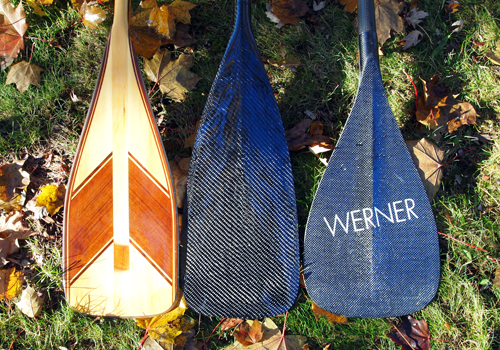
I also really like the grip. A lot of paddles put the seam where the grip is glued on to the shaft, so there’s a little joint under your palm when you push on the paddle grip. It cost a little more to make the grip longer and move the shaft down a bit, but it does make a huge difference.
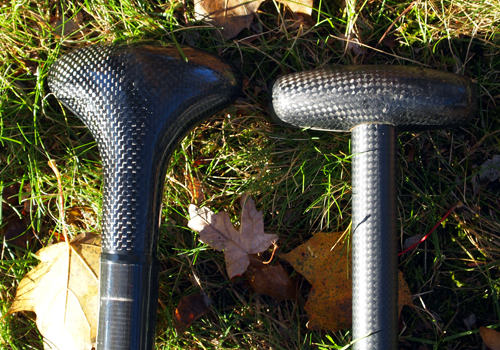
The outrigger T-grip is perfect for outrigger racing, but you can see that an open-palm grip is going to be less effective. The torque placed on an outrigger paddle is considerable, so it makes sense. Grip: 10/10.
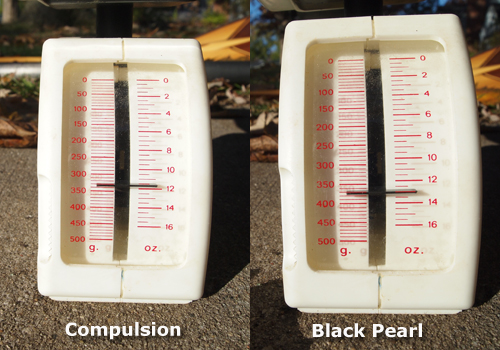
The Black Pearl is quite light. The Compulsion is lighter by a few grams, but my Compulsion is a prototype with a tapered shaft which drops the weight considerably. For production paddles, it’s comparable. The grip changed to ABS on the Compulsion, which brought the weight up a titch.
The other racing paddles I weighed were right around those numbers or slightly heavier. So there ya go. Weight: 10/10.
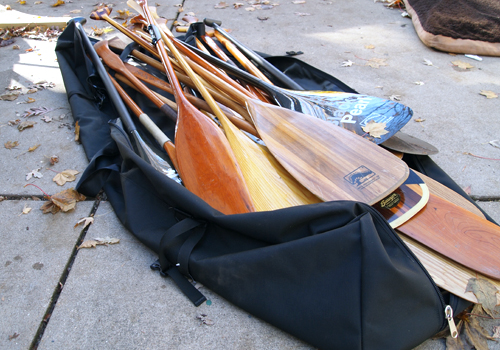
Both paddles performed admirably and have earned a space in my quiver. My quiver is considerable, and that’s only about 75% of it. I think my twenty-something years paddling twenty-something paddles gives me a modicum of credibility in the testing process (he says, polishing his fingernails on his lapel).
At $229, the BP is right between the Compulsion ($260) and most racing paddles (about $200). If you’re a paddler who loves light but wants a paddle designed for touring. here ya go.
Black Pearls will be here soon. Stoked.
Respectfully submitted,
Canoelover

